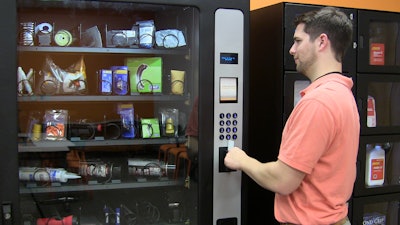
Kent Savage doesn’t see the tool crib for its messy jumble of MRO odds and ends. He sees cost. Cost that manufacturing businesses can hardly afford – that is, if most of them even realize how much money is wrapped up in inventory that may easily go unused.
Savage is the founder of Apex Supply Chain, a company with fruits that seem too bountiful for its relatively young lifespan. The provider of automated point-of-use dispensing and supply chain technologies is about to celebrate its tenth anniversary, and yet it already supports the efforts of 350 of the Fortune 1,000 companies with its solutions.
Much of the company’s success can be attributed to Savage’s long-standing expertise in the traditional vending market. In 1991, with many years of vending experience under his belt, he first introduced the concept of industrial vending. In 2006, he launched Apex Supply Chain.
At that time, the term industrial vending wasn’t common. In fact, inventory solutions were available, but they weren’t being widely adopted. “We came to the conclusion that it was just too difficult to implement, too complicated and too expensive,” says Savage. So the company went to market offering solutions that were designed to be easy to afford, implement and understand.
Vending, Smart Bins
Apex doesn’t consider itself to be an industrial vending company, or a technology company. It prefers to be thought of as a productivity company, and its objectives center on process improvement and cost savings. For Savage, one area ripe for enhancement has always been the tool crib, where highly paid workers must leave a place of productivity to go obtain their supplies. “The products may be very important, but the process for getting them to the workers is very inefficient and non-value-add,” Savage explains.
Bringing supplies to the point-of-work (POW) is a start, as the user is able to eliminate walking, searching waste, and the like. Secondly, a POW industrial vending solution also brings data and accountability into the mix. With each employee tied to an account, it makes it easier to establish restrictions based on employee need. “I can have infinite control over what each worker gets, and how many they get over a period of time. And I can collect data on where and why they’re using it,” he says.
It’s about “using information to replace inventory,” says Savage. Besides addressing the waste and risk around MRO supplies, Apex offers solutions that address direct materials as well. The Actylus Smart Replenishment Solutions (“smart bins”) mean vendor managed inventory (VMI) totally changes. Smart bin technology automatically detects restock levels and sends real-time orders to an ERP system. Not only does this save money for the user (safety stock and emergency orders can be virtually eliminated), but it also can save tremendous costs on the supply side.
In a typical VMI scenario, industrial suppliers are sending their representatives onsite constantly for re-stocks. With Actylus, they have direct line-of-sight on inventory levels without needing to visit the client’s facility. Users can set re-stock levels for whatever “lot” size they deem necessary, so their suppliers can save on these frequent trips to check stock. Savage believes this saves a typical supplier with VMI a minimum of 30 percent on their associated labor costs. For a larger broad line supplier, like a Grainger or a Fastenal, the savings can be even more significant.
Hoarding Inventory
Despite the clear benefits of understanding this dark corner of the business, the Apex team still sees some challenges in trying to educate manufacturing end users on inventory. Specifically, says Savage, “there’s the acknowledged inventory, and then there’s what we like to call ‘ghost inventory’ – all the hoarding, and the stuff that’s tucked away in boxes.”
Ghost inventory can be hard to pry away from individuals, if only because they’re trying to prepare for the worst. In most facilities, the problem – while supported with good intentions – compounds and “there are hoarder effects,” he says. “You wind up with obsolete material that’s never going to be used. Things get lost and damaged.”
The solution, says Savage, is to implement a system that the workforce trusts to have the items they need to do their job when they need them. “But change management is a big part of this, and change doesn’t come easy.”
Savage believes that the consistency of the Apex cloud platform is a big component in establishing this trust, as is the ability to provide real-time reporting and data feeds. “By being in the cloud, we have all the information in one place, so it allows you to see across multiple departments, factories – even countries.” Being able to identify and act on trends quickly is just another way management can support a system that has keen visibility into a complex process.
In the future, customer demands will take standard inventory management and add curveballs. Savage and his team of 150+ technology engineers and software developers look to address challenges like – how can spot buys be on-hand immediately after ordering? How can automated will-call be handled? What about 24-7 access for emergency parts? Savage also predicts some spin-off technology around rentals and temporary use of products, which can go so far as requiring a user to complete brief safety tutorials before they are permitted to check out the item. Oh yeah, and the safety video can be sent directly to the user’s mobile device. “We have a vast R&D program here, working on future products,” says Savage. “We’re investing heavily in it because we believe in it.”
So despite changes in customer needs, Apex is likely to be in lockstep – even if they have to figure out the requirements on their own. “Many times customers don’t know what to ask for, so we start by looking at how they do business. Where are the inefficiencies and the gaps?” says Savage. “Everything is about the customer, and it’s all about eliminating waste.”
Anna Wells is the Executive Editor of IEN. Find her on Twitter: @IndustrialAnna






















